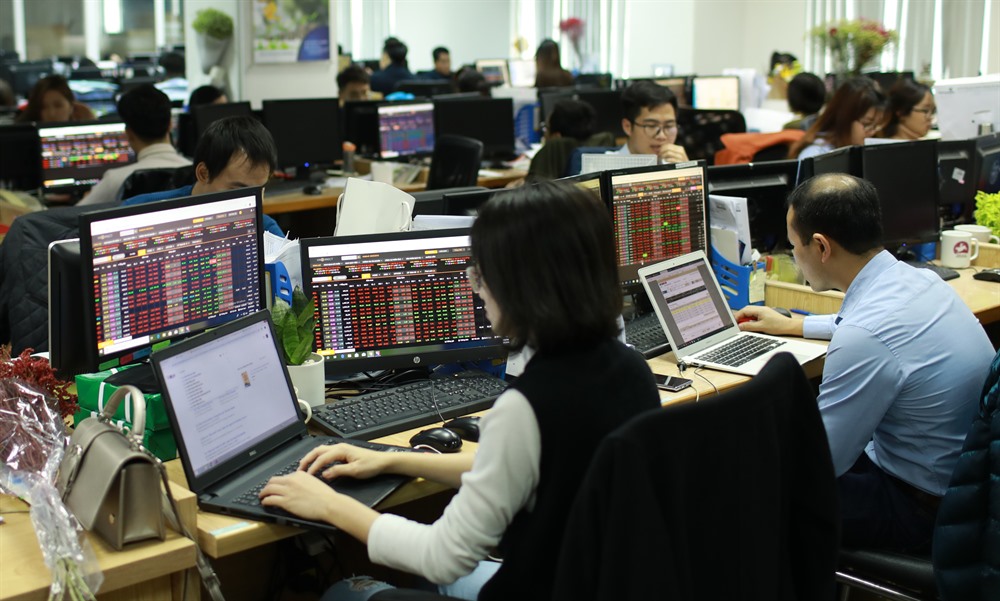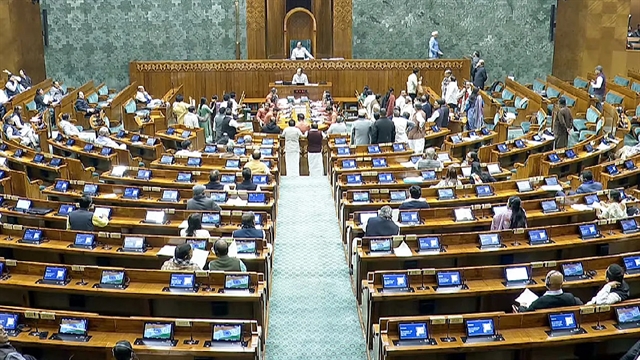 Economy
Economy

Although the uptrend of the VN-Index is expected to be maintained this week, if there is no strong supportive information, it is believed the index would probably move sideways.
 |
| A trading session takes place at MB Securities Company. - VNS Photo Trương Vị |
HÀ NỘI — Although the uptrend of the VN-Index is expected to be maintained this week, if there is no strong supportive information, it is believed the index would probably move sideways.
The benchmark VN-Index on the Ho Chi Minh Stock Exchange decreased by 0.88 per cent to end Friday at 985.25 points, a weekly gain of nearly 0.59 per cent.
The minor HNX Index on the Ha Noi Stock Exchange finished Friday lost 0.60 per cent to end the session at 108.22 points, marking a gain of 0.89 per cent over the week.
An average of 300.6 million shares were traded in each session last week, worth VNĐ5.7 trillion (US$243 million).
“Technically, the market is forecast to still in a struggle and experience a wide divergence next week, with indices strongly influenced by the fluctuations of large-cap stocks, especially Vingroup (VIC), Vinhomes (VHM) and Vincom Retai (VRE),” said Trần Đức Anh, director of Macroeconomics and Market Strategy, KB Securities Vietnam (KBSV).
If there was no strong growth motivation, it was likely the VN-Index would continue moving sideways this week to complete the accumulation process before surpassing the 1,000-point landmark in a convincing way, Đức Anh said.
Việt Nam’s stock market is being negatively affected by the adjustment of global stock markets in the last few sessions, amid concerns of a global economic slowdown.
“I suppose the VN-Index and HNX-Index will correct slightly next week. Sharp decreases would not happen as the demand at low prices is still well maintained,” Đức Anh said.
Bảo Việt Securities Company also forecast the market would face downward pressure this week. The VN-Index may return to the 970-980 points range before a recovery.
“The market is expected to experience a wide divergence next week. Bank stocks are predicted to recover and support the market. Capital is forecast to flow to stocks in the correcting phase, including oil and gas, electricity, industrial zones, textile, building materials, and real estate,” the company said.
“Investors should lower stock exposure to a safe level when market gains. Stock exposure should be limited at 35-45 per cent of the portfolio at present,” it added.
Nguyễn Hoàng Việt, head of market research department at VietinBank Securities Co said the 1,000-point level was a psychological barrier that was pretty difficult to surpass.
Previously, VN-Index had failed to maintain this threshold many times, he said.
According to Việt Dragon Securities Company (VDSC), after three failed attempts to break through 1,000 points, market sentiment became pessimistic and selling pressure quickly overwhelmed.
“Penny stocks performing well in recent sessions were a sign the market may have hit a short-term peak and will have a significant correction. Investors should quickly reduce stock exposure in any technical recovery,” VDSC said in its daily report.
Moving sideways at year end
Viet Nam Bank For Industry & Trade Securities JSC (CTS) said in a recent report that at the end of this year, VN-Index is forecast to go sideways and reach about 926 points.
According to the company, Việt Nam’s GDP growth will reach 6.8 per cent in 2019, other basic indicators are likely to be still under control.
Since the Lunar New Year (Tết) holiday, the market has received positive news: The Fed’s unlikelihood to hike interest rate in 2019 and the future feasibility of an agreement between the US and China.
These, according to CTS, have attracted capital inflows back into the local market.
Within one month from February 4 to March 3 this year, foreign capital inflows into Việt Nam’s stock market reached $111.6 million, CTS said.
However, there was an unfavorable condition for the market, which was the slowing growth rate of corporate profits.
The growth rate of business profits on the HOSE in recent years was always estimated to be higher than revenue growth. This implied that the quality of profit growth should be carefully considered, CTS said.
Notably, profit growth of the whole market and most of the sectors, except for the real estate, were showing signs of slowing down.
Specifically, the overall market profit increased by 9.3 per cent in Q4 of 2018, much lower than the whole year’s figure of 22.2 per cent. Oil and gas and other sectors reported negative profit growth, CTS said. — VNS



.jpg)
